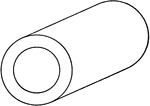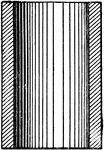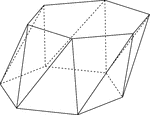
Skewed Hexagonal Antiprism
Illustration of a skewed (non-right) hexagonal antiprism. An antiprism is formed by having two parallel…
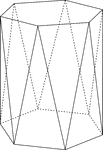
Hexagonal Antiprism
Illustration of a hexagonal antiprism. An antiprism is formed by having two parallel congruent bases…

Nonagonal Antiprism
Illustration of a nonagonal antiprism. An antiprism is formed by having two parallel congruent bases…

Skewed Nonagonal Antiprism
Illustration of a skewed (non-right) nonagonal antiprism. An antiprism is formed by having two parallel…

Nonagonal Antiprism
Illustration of a nonagonal antiprism. An antiprism is formed by having two parallel congruent bases…

Octagonal Antiprism
Illustration of an octagonal antiprism. An antiprism is formed by having two parallel congruent bases…
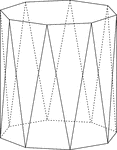
Octagonal Antiprism
Illustration of an octagonal antiprism. An antiprism is formed by having two parallel congruent bases…

Skewed Octagonal Antiprism
Illustration of a skewed (non-right) octagonal antiprism. An antiprism is formed by having two parallel…
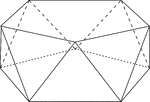
Pentagonal Antiprism
Illustration of a pentagonal antiprism. An antiprism is formed by having two parallel congruent bases…
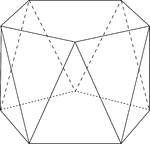
Pentagonal Antiprism
Illustration of a pentagonal antiprism. An antiprism is formed by having two parallel congruent bases…

Skewed Pentagonal Antiprism
Illustration of a skewed (non-right) pentagonal antiprism. An antiprism is formed by having two parallel…

Cyclic Pentagon
Illustration of a cyclic pentagon, a pentagon inscribed in a circle. This can also be described as a…
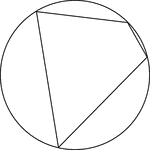
Cyclic Quadrilateral
Illustration of a cyclic quadrilateral, a quadrilateral inscribed in a circle. This can also be described…
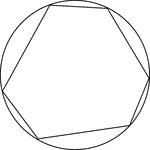
Cyclic Hexagon
Illustration of a cyclic hexagon, a hexagon inscribed in a circle. This can also be described as a circle…
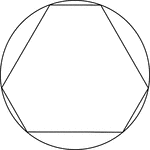
Cyclic Hexagon
Illustration of a cyclic hexagon, a hexagon inscribed in a circle. This can also be described as a circle…
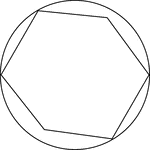
Hexagon In A Circle
Illustration of a hexagon in a circle. Four of the six vertices of the hexagon are bound by the circle…
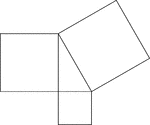
Geometric Pythagorean Theorem Proof
Illustration that can be used to prove the Pythagorean Theorem, the sum of the squares of the legs is…
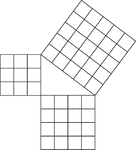
Geometric Pythagorean Theorem Proof
Illustration that can be used to prove the Pythagorean Theorem, the sum of the squares of the legs is…

Pythagorean Theorem Proof by Rearrangement
A visual illustration used to prove the Pythagorean Theorem by rearrangement. When the 4 identical triangles…
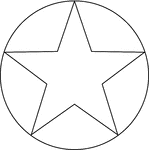
Star Inscribed In A Circle
Illustration of a 5-point star inscribed in a circle. This can also be described as a circle circumscribed…
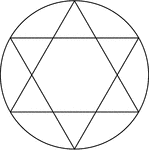
Star Inscribed In A Circle
Illustration of a 6-point star created by two equilateral triangles (often described as the Star of…

Star Inscribed In A Circle
Illustration of a 6-point star (convex dodecagon) inscribed in a circle. This can also be described…

Star Inscribed And Circumscribed About Circles
Illustration of a 6-point star (convex dodecagon) inscribed in a large circle and circumscribed about…
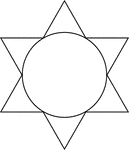
Star Circumscribed About A Circle
Illustration of a 6-point star (convex dodecagon) circumscribed about a circle. This can also be described…
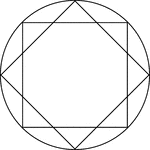
Star Inscribed In A Circle
Illustration of an 8-point star, created by two squares at 45° rotations, inscribed in a circle.…
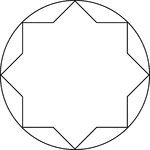
Star Inscribed In A Circle
Illustration of an 8-point star, or convex polygon, inscribed in a circle. This can also be described…

Star Inscribed And Circumscribed About Circles
Illustration of an 8-point star (convex polygon) inscribed in a large circle and circumscribed about…
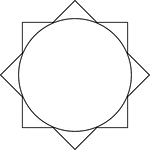
Star Circumscribed About A Circle
Illustration of an 8-point star (convex polygon) circumscribed about a circle. This can also be described…

Projected Geometric View
A body is shown as projecting from its surface projection lines, and these lines are cut by a plane.…

Pattern To Make A House
Illustration of pattern showing steps to make a house. The house is a composite figure made up of a…
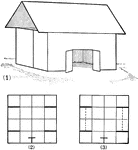
Pattern To Make A Barn
Illustration of pattern showing steps to make a barn. The barn is a composite figure made up of a triangular…

Base Angles In An Isosceles Triangle
Illustration showing that can be used to prove that the base angles of an isosceles triangle are equal.

Equal Segments In An Isosceles Triangle
Illustration showing that if equal segments measured from the end of the base are laid off on the base…
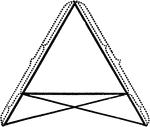
Equal Segments In An Isosceles Triangle
Illustration showing that if equal segments measured from the end of the base prolonged are laid off…
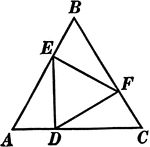
Equilateral Triangle Inscribed In An Equilateral Triangle
Illustration used to prove that triangle EFD is equilateral given that triangle ABC is equilateral and…

Equal Triangles
Illustration used to show that two triangles are equal if the three sides of one are equal respectively…

Construction Of Equilateral Triangle
Illustration used to show how to construct an equilateral triangle, with a given line as a side.

Construction Of An Equal Angle
Illustration used to show how to construct an angle equal to a given angle when given a vertex and a…

Combination of Geometric Solids
Illustration of model created by combining non regular geometric solids.

Oblique View Of Rectangular Solid
Illustration of an oblique view of a rectangular solid/prism at 30°.
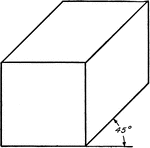
Oblique View Of Rectangular Solid
Illustration of an oblique view of a rectangular solid/prism at 45°.
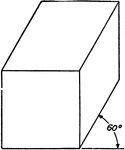
Oblique View Of Rectangular Solid
Illustration of an oblique view of a rectangular solid/prism at 60°.
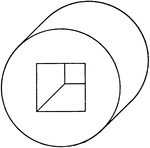
Oblique View Of Hollow Cylinder
Illustration of an oblique view of a hollow cylinder. The portion removed from the center of the cylinder…
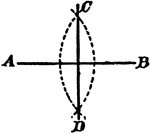
Construction Of A Line Divided In Equal Parts
An illustration showing the construction used to divide a line AB into two equal parts; and to erect…
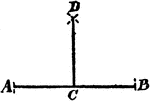
Construction Of A Perpendicular
An illustration showing the construction used to erect a perpendicular. "With C as a center, draw the…
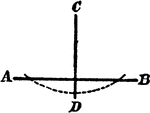
Construction Of A Perpendicular
An illustration showing the construction used to erect a perpendicular from a point to a line. "With…
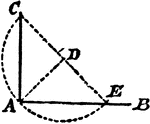
Construction Of A Perpendicular
An illustration showing the construction used to erect a perpendicular at the end of a line. "With the…

Construction Of A Parallel
An illustration showing the construction used to erect a parallel line. "With C as a center, draw the…
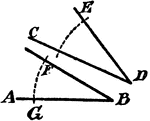
Construction Of An Equal Angle
An illustration showing the construction used to erect an equal angle. "With D as a center, draw the…
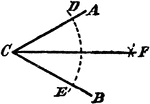
Construction Of A Divided Angle
An illustration showing the construction used to divide an angle into two equal parts. "With C as a…
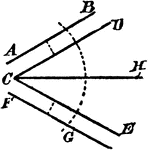
Construction Of A Divided Angle
An illustration showing the construction used to divide an angle into two equal parts when the lines…
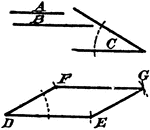
Construction Of A Parallelogram
An illustration showing the construction used to erect a parallelogram given two sides and an angle.…

Divide A Line Proportionately
An illustration showing the construction used to divide the line AB in the same proportion of parts…



